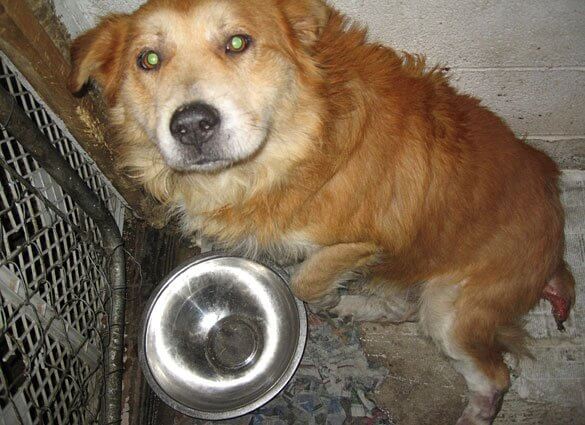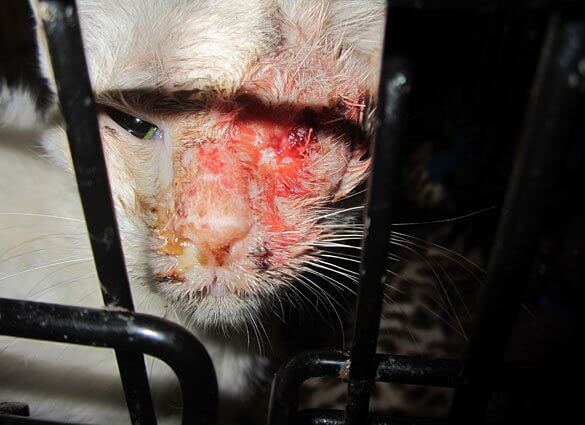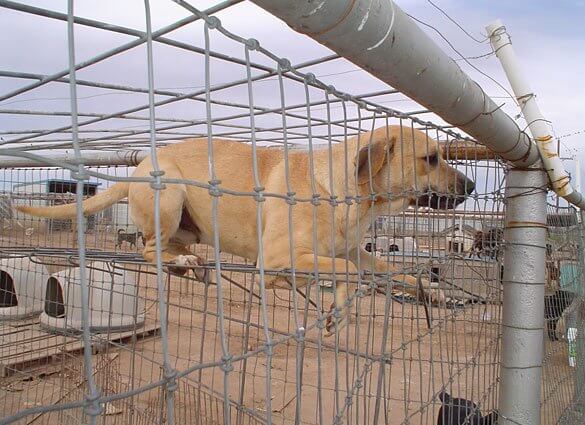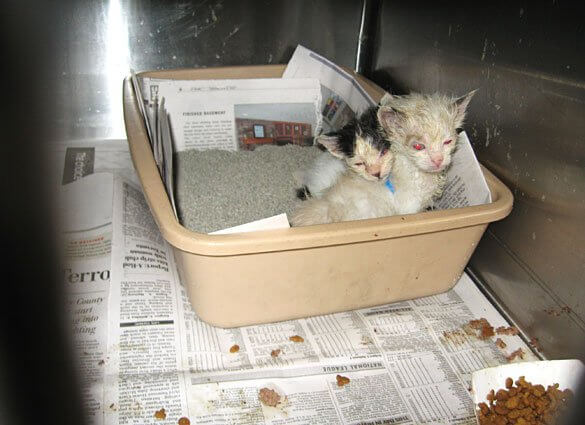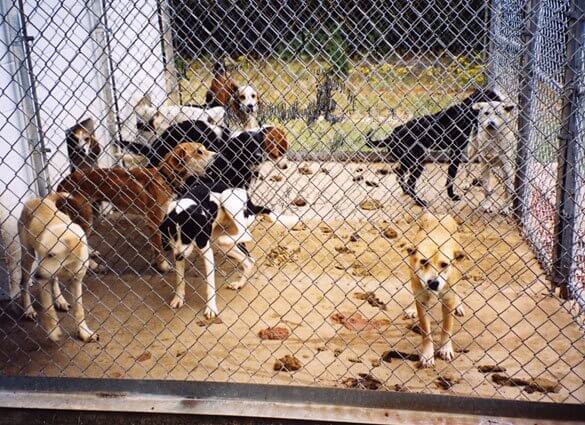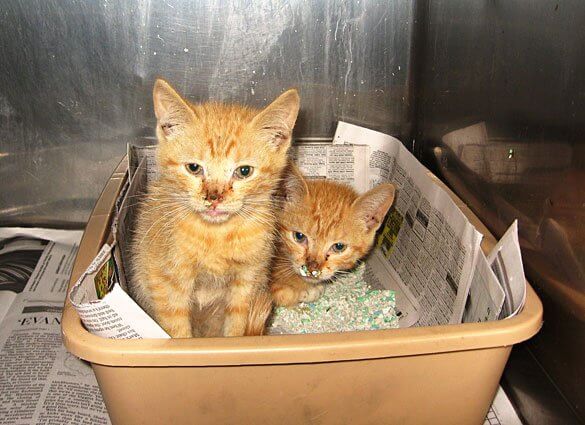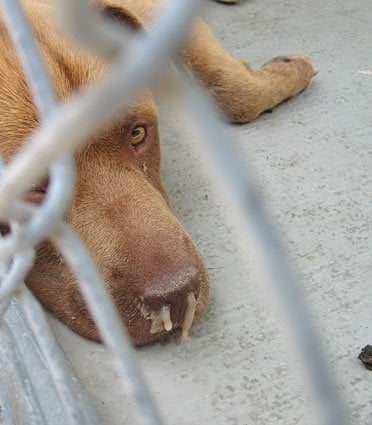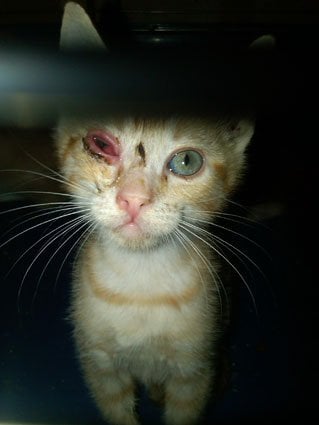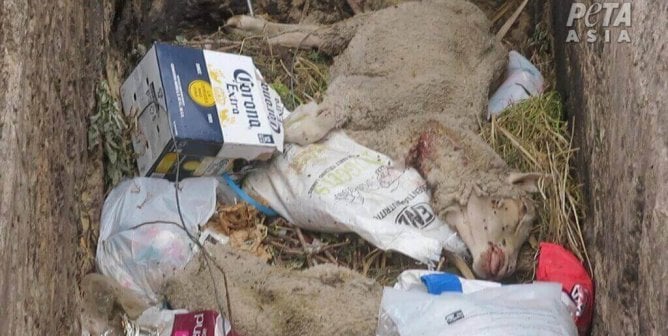‘No-Kill’ Policies Slowly Killing Animals 2013
When “no-kill” animal shelters and rescue groups are filled to capacity, which is almost always, they are left with two options: turn away more animals than they take in or warehouse animals, often in substandard, filthy, and severely crowded conditions, for weeks, months, or even years on end. Most, if not all, of the animals who are turned away from such facilities still face untimely deaths—just not at these facilities.
Instead they are cruelly killed by people who don’t want them, are dumped on roadsides and left to die from starvation or being hit by a car, or spend their short lives homeless, unwanted, and producing more litters of animals for whom no homes exist.
The lucky ones are taken to well-run open-admission animal shelters, where they either find a well-screened, permanent home or are painlessly euthanized in the arms of professionally trained, compassionate people. Here are some of the “no-kill” animal shelter failures that made headlines in recent years for making animals suffer a fate far worse than a kind death.
Reports Showing How ‘No-Kill’ Policies Harmed Animals in December 2013
Chicago, Illinois
The Chicago Tribune reported that the Illinois Department of Agriculture had launched an investigation to find out what happened to more than 1,200 cats transferred from the Chicago Animal Care and Control shelter to an animal “rescue” called Purrs From the Heart in order to lower euthanasia rates at the municipal facility. WGNTV.com reported that the shelter had been transferring animals to the “rescue” for about four years. Approximately 500 animals had reportedly died in the custody of Purrs. No animals were found at a rural barn where the group claimed it had sent many cats, and as many as 150 cats had been left at an apartment where many were reportedly killed, were starved, or died of disease. One of the founders of Purrs was charged with cruelty to animals in 2012 but was acquitted. Charges have not been filed in this most recent case.
Pasco County, Florida
WTSP.com reported that authorities took custody of more than 50 dogs from the nonprofit Sleepy Hollow Dog Rescue after they were found in cages covered with urine and feces. According to WTSP.com, one responder described the property where the dogs were found as smelling so horrible that it “squeezes the breath out of you.” Charges had not been filed.
Reports Showing How ‘No-Kill’ Policies Harmed Animals in November 2013
Town of Union, Wisconsin
WEAU.com reported that the owner of an alleged “no-kill” animal shelter doing business as Hestekin Hill Animal Shelter and Pet Adoption Services was facing multiple felony counts of cruelty to animals after authorities removed 20 animals from the shelter. According to WEAU.com, an examining veterinarian reported “that the smell of feces and urine in the buildings was so strong that they suffered from burning sinuses, coughing and watering eyes.” One dog was found dead in a cage, and others suffered from broken bones and open sores.
Raleigh, North Carolina
WNCN.com reported that Wake County authorities clad in hazmat suits removed 90 cats and three dogs from the home of the president of Calvin’s Paws, a self-professed “no-kill” “animal rescue.” Carol Jean De Olloqui was charged with cruelty to animals. The arrest warrant reportedly accused De Olloqui of depriving animals of food, water, and medical care. The county veterinarian reported that 60 of the cats had to be euthanized because of serious and contagious conditions, including respiratory infections, ulcers, emaciation, and dehydration.
Antioch, California
KTVU.com reported that Last Chance Critter Rescue (LCCR), a self-proclaimed animal “rescue” organization has apparently been soliciting funds under the pretense of being a registered nonprofit. But the state reportedly has no record of the business’s nonprofit filing. The group’s founder, Susie Rae Ray, refused to explain to reporters what LCCR does and referred them to the LCCR website to try to determine what she does with the funds that the organization collects. Ray has been cited by her local animal services department for failing to seek treatment for an injured cat in her custody.
McKeesport, Pennsylvania
WTAE.com reported that, according to an official with the Pennsylvania Department of Agriculture, cases of unlicensed individuals calling themselves “rescues” have been on the rise. The individuals “use social media to garner dogs and donations.” One group, O & P Rescue, has been ordered to cease and desist from soliciting funds. The organization’s cofounder and co-operator, Randy Kovach, has reportedly been convicted of harassment, theft, corruption of minors, conspiracy to sell drugs, disorderly conduct, criminal trespass, running an illegal kennel, and failing to vaccinate dogs. He’s facing charges of assault, selling or trying to sell drugs, and illegally selling and transporting dogs. William Ura, a co-operator of the “rescue,” has reportedly been convicted of forgery, drug possession, disorderly conduct, and retail theft, and he’s facing drug-possession charges.
Reports Showing How ‘No-Kill’ Policies Harmed Animals in October 2013
Kansas City, Missouri
The Kansas City Star reported that authorities seized 68 dogs and cats from a “no-kill” shelter operating as Forever Friends Animal League. The animals were being kept in conditions described as “dirty” and “unsanitary,” and several suffered from respiratory infections. The “no-kill” facility had reportedly received previous citations for violating municipal and animal control codes and regulations.
Erie County, Ohio
The Sandusky Register reported that the Erie County Humane Society has a three-month waiting list to accept cats and that the agency’s executive director acknowledges the dangers. People “dump cats on the doorstep after hours,” the story said, “in an apparent move to try to avoid the shelter’s waiting list.” “The people who want to bypass the waiting list, they find a way to get to us,” the executive director said. “Usually it involves dumping.” It was also reported that as unweaned kittens die slowly one by one in foster homes, foster families are finding the undertaking unbearable and are quitting.
Boulder, Colorado
TimesCall.com reported that the Longmont Humane Society was cited on suspicion of keeping a dangerous dog, after a dog in foster care attacked a neighbor and his dog, who was being walked on a leash. Police officials reported that a disproportionate number of dog bite incidents involved dogs who were adopted from the shelter, which is striving to increase its “live release” rates.
Macon, Georgia
Georgia Public Broadcasting reported that approximately 70 dogs at the “no-kill” shelter All About Animals were released from cages after hours by an unknown person. When volunteers arrived in the morning, dogs were still fighting, so “volunteers used water from hoses to separate the survivors so they could be re-caged.” Three dogs died as a result of the fights, and more than a dozen were badly injured and required medical care. There were no suspects in the case.
Lancaster County, Pennsylvania
The Conestoga Valley News reported that the Lancaster County SPCA had an eight-month waiting list for the only service provided to homeless cats in the community—trapping and sterilizing the animals and then returning them to the neighborhood, even if they were considered to be a nuisance.
Placerville, California
Local ABC affiliate News 10 reported that an unlicensed animal shelter was under investigation after county law-enforcement officials received statements and photographs from eyewitnesses documenting that at least 17 dogs were being continuously kept in training crates and travel carriers, often without water. A former volunteer stated, “There’s never been water in the crates in the four months I lived there. They go out twice a day for maybe two to eight minutes tops to go to the bathroom.” Nine dogs were seized, and the remaining animals were to be removed.
Apple Valley, California
The Daily Press reported that law-enforcement officers removed 28 live dogs, three dead dogs, and dozens of dog crates from German Shepherd Angels Rescue. Authorities found dogs housed in plastic airline carriers in a garage, excessive waste, and far more animals than the legally allowed limit of four. It was not the first time that officers had official contact with the “rescue,” and citations were issued for at least the second time.
Knox County, Tennessee
The Knox County Sheriff’s Office reported that officers and veterinarians seized 41 cats from Almost Home Animal Rescue after the majority of the animals were found housed in an unventilated dark basement that smelled strongly of urine and contained litterboxes that were overflowing with waste. Puddles of urine and diarrhea covered the basement floor, and a cat was found with his or her head pinned behind an unused refrigerator and had been stuck like that for “an unknown amount of time.” The “rescue’s” owner will reportedly be cited for cruelty to animals and be required to comply with the legal limit of five animal companions per household.
Portsmouth, Virginia
Local ABC affiliate WVEC reported that the Portsmouth Humane Society (PHS), under contract with the city of Portsmouth, was fined for “critical failures to provide adequate care” by the Virginia Department of Agriculture and Consumer Services (VDACS) following a routine inspection. VDACS found that PHS staff were regularly directed to “adopt” cats and release them into a small wooded area behind the facility between a busy highway and active railroad tracks. More than 90 cats had been abandoned in the area, where no water was provided and rotting food was found scattered on the ground at the edge of a parking lot. Former staff members told the Pilot Online that approximately 300 cats had been removed from the shelter by staff members, who abandoned the animals in other parts of the community to improve “live release” rates. During an August 2013 inspection, dogs were found in severely crowded runs and in crates that were so small that they couldn’t stand. PHS had been striving to become a “no-kill” shelter, and former staff reported that cats were commonly released and purposely allowed to escape to improve the organization’s adoption and euthanasia statistics.
Reports Showing How ‘No-Kill’ Policies Harmed Animals in September 2013
Toledo, Ohio
NorthwestOhio.com reported that a dog named Bones, deemed dangerous in New York, was “rescued” from euthanasia by a group called The Lexus Project and transported to Northwest Ohio Underdog Rescue, Inc. (NOUR), in January 2012. Bones’ body was recently uncovered in a shallow grave on the NOUR property. Nine months earlier, the “rescue” claimed that Bones had been stolen. More than half a dozen dogs and cats were found buried at the same site. No charges were filed, and the investigation was closed.
St. Clair County, Michigan
The Times Herald reported that 24 cats were found so severely ill in the home of Forgotten Feral Cat Rescue’s operator that all had to be euthanized. The cats were reportedly found “covered with sores and riddled with fleas.”
Southbury, Connecticut
NBC Connecticut reported that 31 dogs and three cats were removed from a property identified by the Republican American as an animal “rescue” called Sad Tails, Happy Endings. The animals were seized after law-enforcement agencies determined that there was “a real concern for their well-being.”
Atwater, California
The Merced Sun-Star reported that the Merced County Animal Control sent nearly 2,000 cats and kittens to the Last Hope Cat Kingdom “no-kill rescue” between July 2008 and June 25, 2013, the day the “rescue” was raided. Six kittens had been sent to the “no-kill” facility on the same day as the raid. On June 25, authorities removed nearly 300 cats from Last Hope, 200 of whom had to be euthanized because of critical health issues, including contagious diseases. ABC-30 reported that another 74 dead animals were removed. Some were found in cages with live animals.
Otero County, New Mexico
The Albuquerque Journal reported that authorities found more than 200 dogs in “deplorable” conditions at the Mission Desert Hills Sanctuary for Dogs “no-kill rescue” in Chaparral. KFOX-14 reported that several of the dogs also had “severe internal injuries” indicating that they had been sexually assaulted “either by a human or an instrument.” A volunteer who helped with the removal of the animals from the property said that she was stepping over dead dogs to get to live ones who were “living in hell, in their own feces, no water, no food, [and] emaciated.” KTSM News Channel 9 reported that while sheriff’s deputies worked to obtain permission to enter the property, neighbors saw dogs fighting with one another, and several of those dogs died as a result. The case was under investigation.
Northampton County, Pennsylvania
The Morning Call reported that since the only local animal shelter has become a “no-kill” facility, it is “chronically over-crowded” and is essentially closed to animals in need. At a meeting to discuss options for handling lost and homeless animals, the Northampton County sheriff described “policemen spending entire shifts trying to locate dog owners and driving [dogs] to shelters that will take them, in some cases a couple of counties away.”
Nova Scotia, Canada
The Burnside News reported that an internal review at the “no-kill” Nova Scotia SPCA revealed that there were more than 1,000 cats on a “severe” waiting list to be admitted.
Reports Showing How ‘No-Kill’ Policies Harmed Animals in August 2013
Semmes, Alabama
AL.com reported that more than 60 animals were seized from the “no-kill rescue” group Safe Haven Animal Care Kennels after authorities investigated a report that a puppy was “attacked viciously” by another dog at the “rescue.” WKRG.com reported that animals there had a multitude of health problems, including upper respiratory infections, ringworm, and injuries. The raid took place just two months after two dogs reportedly died of heatstroke at the facility.
Genesee County, Michigan
MLive.com reported that the Genesee County Animal Shelter “has been over capacity for cats from the moment the no-kill directive was issued and hasn’t accepted additional stray or unwanted cats or kittens because of that.” Veterinarian Michele Koan asked county leaders to reverse the order because of the overcrowding, the inability to accept cats from the public (resulting in an increase in animal dumping after hours), and the spread of contagious illnesses throughout the facility. Dr. Koan reports that the shelter “has spent more on antibiotics for the cats in two weeks” than the county spent on the medication in two years for both cats and dogs and that the ban on euthanasia has “created more suffering than good for cats and kittens.”
Clay County, Indiana
The Brazil Times reported that, frustrated from long-term confinement, dogs at the “no-kill” Clay County Humane Society have attacked employees, other animals, adopters, and a board member. The shelter is considering euthanizing some dogs who have no chance at adoption and have become too dangerous to release. Deeply concerned about the dogs, board President Charles Hear said, “What is the more humane thing to do? Leave these animals in solitary confinement until they die of natural causes or to humanely euthanize them?”
Douglas County, Georgia
The Douglas County Sentinel reported that charges may be filed after authorities removed approximately 80 cats from cages stashed in sheds and barns on a property linked to the “no-kill rescue” Snap-2 IT. On August 14, 2013, the Sentinel reported that “many of the cats still had tags that indicated that they had been taken from the Douglas County Animal Shelter.” The cats were found in “unsanitary conditions,” and many suffered from respiratory disease, including “coughing and wheezing,” and “eye issues, running and watery.” The Sentinel reported on August 17, 2013, that former Animal Control Director Rick Smith wrote to one county commissioner, “This situation is the result of not inquiring or investigating where animals being pulled are sent. … If you recall I brought my concerns about these rescues … to your attention… As a result of sweeping this concern under the rug, you have allowed animals to be placed in harm’s way. This situation is criminal and those responsible should be held accountable.”
Hamilton County, Indiana
TheIndyChannel.com reported that the Humane Society for Hamilton County was considering if its “no-kill philosophy is realistic, given its issues of overcrowding, the number of elderly animals and the mounting medical bills.”
Green Springs, Ohio
The Toledo Blade reported that after the removal of 70 cats, including four dead kittens, from her trailer, an animal hoarder revealed that she had rescued three cats who were freezing one winter and couldn’t afford to get them spayed and neutered. As the cats reproduced, she sought help. “I would call all of the humane societies and shelters within a 70-mile radius,” she said, “and they were always full and wouldn’t take any of them.” The hoarder, facing cruelty-to-animals charges, told the news outlet that she was relieved to have the cats removed.
Dayton, Ohio
The Dayton Daily News reported that the Humane Society of Greater Dayton—which has a limited-admission policy and requires appointments, charges admission fees, and keeps a waiting list when at capacity—routinely has animals abandoned near its facility. In one week, 11 animals were reportedly dumped there, one of whom was a small dog who was run over and killed by a car.
Shelbyville, Tennessee
WSMV.com reported that local “rescuers” John and Sabrina Crowder are facing criminal charges because of conditions in which they kept 49 dogs in their single-family dwelling, which was condemned after authorities removed the animals. Police said that “when they walked in, they saw piles of animal waste, and two officers were apparently so overwhelmed by the smell, they actually got sick.”
San Antonio, Texas
mySA.com reported that while the city’s Animal Care Services shelter “has been touting that it has averaged a live release rate of 79 percent since January,” the statistic represents only those animals who are actually admitted to the animal shelter. The shelter has rigid and restrictive admission policies that make it virtually impossible for owners to surrender animals: It requires an appointment for surrender, but appointments are made only between 7 and 10 a.m. on Wednesdays, and animals are admitted only four days a week between 11 a.m. and 5 p.m. It also charges a $40 admission fee and requires people to bring the names of at least two other organizations with which they have tried to place the animal. Approximately 16,000 dogs and 12,000 cats who didn’t make it to the shelter were picked up dead last year after being hit by cars, succumbing to disease or injuries, or dying in other agonizing ways.
Sussex County, Delaware
DelawareOnline.com reported that things got so bad at the “no-kill” Safe Haven Animal Sanctuary in Delaware (where pro–”no-kill” legislation was passed in 2010 with disastrous results for animals and taxpayers) that the county government revoked its dog-control contract. “The problem is your business model. It doesn’t work. It’s not going to work,” one county commissioner told Safe Haven. The head of the Kent County SPCA, the state’s largest open-admission shelter, said, “The expectation of our community is that every animal will be saved, but there’s not enough money to pay for it.”
Barry County, Michigan
WWMT.com reported that six months after the Barry County Animal Shelter became “no-kill,” the cat population “exploded” to more than double the number that the shelter can handle. The state Department of Agriculture intervened, forbidding the shelter from accepting more cats until the current population is reduced.
Denton County, Texas
The local NBC website reported that the Denton County Sheriff’s Office, with assistance from the Humane Society of North Texas, seized approximately 200 dogs from the “no-kill rescue” Animal Guardians of America. Sheriff Will Travis reported that dogs were crammed into small cages in sheds and that the smell “was unbearable and the cages were covered in filth and feces.” A longtime volunteer told the news station, “This has been going on for eight years out here. … I was out here six years ago, and she’s always had 200-plus dogs. There was poop everywhere. Dogs were living in crates. They were being fed every other day. … We saw nine dogs die out here in a year and a half.” The case is under criminal investigation.
Reports Showing How ‘No-Kill’ Policies Harmed Animals in July 2013
Miami, Florida
The Miami Herald reported that one year after adopting a “no-kill” resolution, the city shelter experienced extreme overcrowding. An urgent e-mail from the shelter’s clinic supervisor reportedly stated, “The space situation is out of control. … We are over 100 dogs OVER our capacity.” The supervisor explained that “[w]e have limited resources in labor and space. The variable which we have no control over is intake.”
El Paso, Texas
KVIA.com reported that El Paso Animal Services removed 54 dogs and one cat from a hoarder’s single-family home because of the poor conditions and that criminal charges were pending. The hoarder told a neighbor that she had adopted the dogs from the city shelter to “save them” from euthanasia.
Austin, Texas
KVUE.com reported that all three Austin-area “no-kill” shelters, including the city-operated taxpayer-funded facility, were “at capacity” with 2,000 homeless cats and kittens and had stopped accepting any felines. Just one month earlier, the city reported that “for the first time in its history,” the Austin Animal Center would not accept animals for whom citizens could not or would not care, because of overcrowding at the “no-kill” shelter, which had “more than 1,000 [animals] available for adoption.”
Hillsborough County, Florida
The Tampa Tribune reported that the Hillsborough County Commission agreed to release $250,000 in emergency funds to address problematic conditions at the county animal shelter after adopting a “low-kill” policy. The shelter was reportedly so overcrowded that dogs and cats were contracting contagious diseases and dying. “If someone from Animal Services came to my home and inspected my home and my dogs lived in the conditions that exists [sic] in this county [shelter], they would confiscate every one of my dogs and shut down my rescue,” said a man who runs a local bulldog and boxer rescue group.
Anniston, Alabama
Fox 6 reported that the Mad Cattery “no-kill” group was issued multiple citations for cruelty to animals after 49 cats were found stored in a building with no water or food. One cat was dead, and authorities removed 11 others. The director of the county’s animal control department told The Anniston Star on July 12, 2013, that the group was under investigation, describing the building as “unsanitary” and reporting that the cats were in “various stages of upper respiratory infections,” had “no food and no water,” and had been in the building for nearly a month.
San José, California
KTVU.com reported that nearly 100 cats died in melting plastic travel carriers in a house fire at the home of hoarder Carole Miller, founder of the “no-kill” Stanford Cat Network. San José Fire Capt. Reggie Williams told KTVU that firefighters were hindered in their efforts to get the blaze under control because of all the cats that were in the home: “There were multiple, multiple animals we had to get over to fight the fire. … I’ve never witnessed this many animals in a single home… There were more than 100 cats.”
Fredericksburg, Virginia
The Free Lance-Star reported that two women driving a vehicle registered to an out-of-state animal “rescue” were charged with four counts each of cruelty to animals after police responded to a complaint about four puppies left inside a hot van and found the animals confined to crates in the vehicle. The dogs had been locked in the van for at least an hour in the 80-degree heat, and no water was available to them. The women were cited and required to take the dogs inside the air-conditioned hotel room in which the women were found and provide the animals with water.
Framingham, Massachusetts
The MetroWest Daily News reported that self-professed animal “rescues” continue to bring dogs illegally into Massachusetts via unlicensed dog “haulers,” some of whom will meet with adopters just shy of the state’s border. As a growing number of adopters and “rescues” use online databases such as PetFinder.com to adopt out-of-state dogs based on photographs and unsubstantiated personality descriptions, the state has implemented strict import rules. However, adopters continue to be directed to meet at rest stops and parking lots to pick up animals, many of whom come with a slew of health problems, including contagious diseases. The news outlet reported that the state of Massachusetts has “issued $44,250 in fines to 14 out-of-state dog rescue organizations and seven in-state shelters for unlawful practices,” and it shared a list of them.
Kalispell, Montana
A “no-kill” animal shelter representative told DailyInterLake.com that kittens left on the doorstep of the facility had clawed their way out of the cardboard box that they were confined to over the Fourth of July holiday. It’s unknown how many kittens had been left in the box. Two were found, one of whom had climbed a tree out of fear. The shelter is reportedly close to a busy highway.
Atwater, California
The Merced Sun-Star reported that of 301 animals removed from Last Hope Cat Kingdom in June, approximately 200 had to be euthanized “because they were too sick to survive.” The “rescue” was apparently still soliciting donations on its Facebook page as of this writing. (See June 27, 2013/Atwater, California.)
Tampa, Florida
A veterinarian who worked at the Hillsborough County Animal Services shelter for 13 years told the Tampa Bay Times that she was compelled to resign because of “increasing numbers of animals getting sick, dangerous dogs being made available for adoption to families and a lack of professional treatment from new management” after the shelter implemented rules that prohibit euthanizing animals who arrive sick. The shelter has also extended hold times in a bid to increase the number of adoptions. The board member of a local “rescue” group said, “If the public treated their animals like this, we would be arrested and charged with animal cruelty.”
Apple Valley, California
The Huffington Post reported that on June 18, 2013, authorities seized more than 130 dogs from Rainbow’s End Animal Sanctuary. They had been found “living in one large pack for years without proper food, medical care or human interaction.” Some reportedly had to be euthanized for medical reasons, and the rest will be released only to rescue groups because of the expensive and extensive medical care and behavioral work that they need.
Milton, Florida
PNJ.com reported that 103 of the 225 cats taken from Kirkham Kattery Rescue, an animal “rescue” group that a couple ran out of their home, had to be euthanized because of their critical medical conditions. The pair was arrested and charged with violations of health and safety codes and cruelty to animals. Cited in an arrest report were eyewitness complaints about “extremely skinny cats with hair loss, fluid, blood and puss around the cats’ noses, eyes and genitals” and conditions that were “extremely dirty with feces and urine everywhere [and] … an extremely foul stench.”
Reports Showing How ‘No-Kill’ Policies Harmed Animals in June 2013
Sumiton, Alabama
WVTM-TV reported that local police removed nearly 150 animals from Nonnie’s Angels animal “rescue” after complaints of animal neglect. The animals were found crammed into a small building that lacked air conditioning. WSET-TV video footage showed caged cats open-mouthed panting because of the crowding and lack of ventilation. Assistant Police Chief Scott Karr reportedly said, “It was at 92 degrees at 7:30 at night inside the building. There was no air movement. The animals were lethargic. Many had mites, fleas, skin conditions.” An investigation was undertaken, and cruelty-to-animals charges may be filed.
South Zanesville, Ohio
The owner of South Zanesville Animal Rescue Services told WHIZNews.com that after five months, the facility needs more space and funding. The “no-kill” shelter reported that it had recently turned away 37 animals in need in just four days.
Atwater, California
The Merced Sun-Star reported that law-enforcement officials seized “[h]undreds of sick, dying and dead animals” from Last Hope Cat Kingdom, a self-professed “no-kill” animal “rescue.” A veterinarian who examined cats taken from the facility reportedly found that more than 80 percent of them “had severe and ongoing infections involving the eyes, nose, mouth, throat, ears and skin.” A total of 74 dead animals, some of whom were caged with live ones, were also removed from the facility.
Elyria, Ohio
Unless she can find a home for her 15 to 20 cats, a 70-year-old woman on Social Security will be unable to make improvements to her home that are required in order for her to stay in it legally, she told The Chronicle-Telegram. Local “no-kill” shelters had no room to accept the cats for whom she cannot care and who are destroying the house, and the government-run shelter handles only dogs. The news outlet reported that the woman “has been turned away [from shelters] repeatedly … by animal groups who all say the same thing. They, too, have more cats than they can handle.”
Sussex County, Delaware
CapeGazette.com reported that just a little more than a year after opening, the Safe Haven Animal Sanctuary may have to close its doors because it’s running out of money and its leaders “say they underestimated the number of abandoned animals and the difficulty of getting them adopted.” To maintain a reported “no-kill” label, shelter officials told CapeGazette.com that a lot of money was being spent on using outside kennels to board unadopted dogs. Since its opening, numerous animals—including “cats taped into boxes”—have been abandoned at the shelter’s front gate.
Knoxville, Tennessee
While many animal shelters are offering free adoptions to increase their “live-release” rates, the Young-Williams Animal Shelter told WBIR-TV that at least three animals adopted from its shelter without a fee were sold for a profit on Craigslist.
Monterey County
The Californian.com reported that “[t]he SPCA for Monterey County seized 17 neglected animals, including 14 dogs and puppies, one kitten and two birds, from a woman claiming to run a rescue group [called St. Francis All Creature Rescue and Sanctuary] adopting them at PetSmart in Sand City …. The dogs and puppies range in age from 12 weeks to four years old. They are being treated for scabies, fleas, and skin infections. All the dogs are thin. The birds were hungry, housed inhumanely, and suffering from feather loss …”
San Antonio, Texas
The Current reported that animal control officers in San Antonio expressed concern over what one called “euthanasia by proxy” at the city’s animal shelter. The officers indicated that while millions of dollars are being poured into efforts to turn the city shelter into a “no-kill” facility, thousands of homeless animals remain on the streets because of a lack of field staff and understanding by shelter and city leaders. Animal Control Officer Thomas Stowers reported, “Public Works scrapes over 30,000 dogs from the sidewalks and streets because they’ve been hit by cars … this is euthanasia by proxy, and it’s cruel.”
Orange County, Florida
WFTV.com reported that 17 dogs and two cats were removed from ghastly conditions at Ohana Animal Rescue where they had been neglected in conditions described by law enforcement officials as “the worst we’ve ever seen.” Dogs were suffering from hair loss, infections, and starvation. The self-professed “rescue” had been given animals by Orange County Animal Services (OCAS) and reportedly acted as a foster home for two other so-called rescues that also remove animals from OCAS. An OCAS representative told WFTV.com, that the agency “adopts out 30 to 40 animals a day and said it cannot do home inspections for everyone.”
Austin, Texas
In a city news release with the headline “Animal Shelter: Find a home for your pet, do not bring it here,” the “no-kill” taxpayer-funded animal shelter advised that “for the first time in its history, [the shelter] is not accepting animals surrendered by owners” and was giving away animals free of charge because of being, “over capacity by more than 100 kennels for both dogs and cats.”
Genesee County, Michigan
YNN.com, Rochester, reported that the Genesee County Animal Shelter’s volunteer board president, Andre Miller asserted: “We are currently turning people away at the door with kittens that they found in parking lots or boxes, and it’s heart-breaking to turn them away, because you don’t know what [sic] going to happen with the animal.” The county shelter has been under unrelenting pressure to go “no-kill.”
Reports Showing How ‘No-Kill’ Policies Harmed Animals in May 2013
Bryan, Texas
KBTX.com reported that the overcrowded Bryan Animal Center “is desperate for adoptions or fosters to avoid having to euthanize any of the animals.” The center supervisor told KBTX.com that the shelter was “overflowing into smaller crates as well.” Small crates reportedly “line the hallway” of the shelter.
Sheffield Township, Ohio
The Plain Dealer reported that 55 animals were removed and Ohio Pet Placement was shut down after officials found “overflowing feces-filled trash cans and no electricity or running water” at the self-professed “rescue.” According to a witness, “[M]ost of the animals have medical or psychological problems.” A volunteer had reportedly recently filed a complaint with the state veterinary licensing board alleging that ill cats were not receiving needed medical treatment.
Warner Robbins, Georgia
Newscentralga.com reported that a “Middle Georgia animal rescue group is at capacity and is turning away sick dogs. Critical Care for Animal Angels said it must reject more than 10 dogs a day that need medical treatment.” A representative of the group told the outlet, “We turn away at least 10 to 20 a day, every day. … I cry a lot because we want to help them all and it hurts to turn away a dog that you know needs you.”
Portland, Oregon
KATU.com reported that a complaint had been filed with the Oregon Department of Justice against Animal Miracle Foundation and Network charging that the “rescue” group raised funds to pay for veterinary care for a cat who was tied up and burned with chemicals in Michigan, then failed to forward collected funds to the hospital or group handling the animal’s treatment.
Reports Showing How ‘No-Kill’ Policies Harmed Animals in April 2013
Stone County, Mississippi
The Sun-Herald reported that repeat offender Shirley Gai was arrested after authorities seized approximately 100 dogs and “found several dead dogs inside and outside the home, some stuffed in garbage bags or old dog food bags. [Stone County Chief Deputy] Olds said the home’s floors were caked in feces and urine. None of the dogs had all of their hair and most suffered from contagious forms of mange and had numerous sores. Authorities said all had ear, eye and respiratory infections.” Some dogs reportedly survived by eating other dogs. Gai claimed to have adopted dogs from animal shelters and picked them up as strays to “save” them.
Highland County, Ohio
TimesGazette.com reported that “a search warrant was served in relation to what was thought to be over 100 dogs being kept by Cares About Life Rescue, Inc. The dog warden and investigators visited the property … and said they found over 120 dogs living in inadequate conditions and two that were deceased.” Video footage shared by the news outlet shows dogs perched on top of damaged doghouses unable and/or unwilling to walk in filthy deep mud- and waste-flooded floors in ramshackle pens. Many of the animals were panting excessively because of exposure and an apparent lack of drinkable water.
Goochland County, Virginia
WWBT-TV reported that the operator of The Pet Rescue Foundation was banned from “having any kind of pet” after authorities charged her with cruelty to animals. Five dogs removed from the “rescue” were in such poor condition that they required immediate euthanasia. Seventy more dogs were removed for assessment and care.
Reports Showing How ‘No-Kill’ Policies Harmed Animals in March 2013
Miami, Florida
The Miami News Times reported that Have a Heart Dog and Cat Rescue “looks more like a haunted house” than a rescue. The facility, operated by an apparent hoarder, was under investigation after county officials received complaints about “painful howls piercing the night” and “mangy, sore-ridden dogs” living in filth. CBS Miami reported that neighbors took pictures inside the home that show several dogs living in filth, the floor covered in garbage, rotting furniture, and dog feces.
Swain County, North Carolina
Citizen-Times.com reported that a veterinary hospital worked tirelessly to rehabilitate a dog who was found by a local citizen, “wrapped in a white trash bag in a Dumpster. … A dead dog was lying in the trash bin along with the young dog …. The [living] dog suffered a crushed muzzle, according to [the citizen’s wife] Love Carswell. ‘It took a heck of a lot of force. The dog was bleeding through [his] nostrils, and [he] could not open [his] mouth there was such heavy swelling,’” she explained. The only shelter in the county is a “no-kill,” turn-away shelter. Veterinarian Jessica Tracy reports that, “[t]his is unfortunately something that people do. They try to knock the animal out and wrap it in the bag so it suffocates.” Citizen-Times.com goes on to report that “Love Carswell, who is a retired 911 dispatcher, said she received hundreds of calls about animal abuse over the years …. One of our dogs, this lady called and said, ‘If you don’t have somebody come and pick up this pup, I’m going to drown it’ …”
Elma, New York
The Buffalo News reported that authorities raided Smilin’ Pit Bull Rescue and charged the owner with cruelty to animals. Five dogs were removed in response to allegations, including “that dogs had been denied veterinary care for injuries or illnesses and had deteriorated while in the group’s care [and that] dogs had been confined to crates for extended periods.”
Woodbridge, New Jersey
NJ.com reported that an ex-animal control employee and so-called “rescuer” involved with Happy Homes Animal Rescue was arrested and “charged with hundreds of counts of animal cruelty” after officials found “hundreds of animals—both dead and alive” on her property including, “more than 50 roosters and chickens, 15 to 20 rabbits, a domesticated raccoon, a parrot and hundreds of cats …[and] [d]ead cats stuffed in too many grocery bags to count …”
New Port Richey, Florida
After New Port Richey handed over much of its animal control operations to volunteer “no-kill” fanatics in an attempt to reduce costs, the Tampa Bay Times opined that the “New Port Richey’s animal control experiment is failing, and the city must repair or replace this amateurish department with a professionally led effort.” Continuous problems, complaints, and cover-ups were cited as well as the resignation of a professionally trained animal control officer who reported that the unit “allowed sick animals to suffer rather than violate the department’s self-adopted no-kill policy.”
Santee, South Carolina
The Times and Democrat reported that the operator of Coastal Jack Russell Terrier Rescue “was ordered to stop ‘rescuing’ dogs … after she was charged with three counts of ill treatment of animals.” The “rescue” reportedly confined dogs “in advanced stages of malnourishment … in need of food, water and medical attention.” It was also reported that “dogs were left to sit in cages, pens and crates amongst excessive amounts of feces and urine.” Bags of dead dogs were found “in the vicinity” of the sick and starving animals at the property. The appalled judge on the case stated, “I saw the pictures. … I am very adamant that she have no animals under her control. None!”
Reports Showing How ‘No-Kill’ Policies Harmed Animals in February 2013
Marcus Hook, Pennsylvania
The Philadelphia Inquirer reported that officials raided a property connected with Sixth Angel Shepherd Rescue, where “28 malnourished German Shepherds and shepherd mixes, including a puppy, a pregnant female and one dog so old and sick it had to be euthanized” were removed. Conditions reported by law-enforcement officials were horrific: “Every place in the building was covered with urine and feces,” an official told the Inquirer. According to the article, the official also noted that dogs had been packed into crates and locked in rooms. Reportedly, the “rescue” had previously been cited “in connection with an illegal dog transport bringing dogs from a North Carolina shelter to [the facility]. [The operator] was charged with purchasing dogs in a public place. The driver of the transport van was cited for housing animals in filthy cages and 17 dogs were seized by humane officers.”
Nixonton, North Carolina
The Daily Advance reported that the Pasquotank County Sheriff’s Department removed more than 70 cats from Angela’s Angels Cat Rescue. Cats were reportedly released to the “rescue” by open-admission animal shelters in an attempt to increase their “live release rates.” The cats were found in “squalid conditions,” and “the majority of the offices [were] filled with cats.”
Willoughby, Ohio
Fox 8 Cleveland reported that authorities seized 85 cats and three dogs from the Western Reserve Humane Society in what was called “one of the largest cases of animal hoarding ever in Lake County.” The county humane officer was quoted describing conditions: “We couldn’t breathe, eyes were burning, throat was burning. … The animals were very ill. A lot of them sneezing, eye discharge, just lethargic, skinny. … There was one cat that was missing all of its fur — scabs, crusty skin all over. Every corner you turned, there was a cat that needed help.” The facility’s operator was convicted of cruelty to animals.
Parkville, Maryland
CBS Baltimore reported that the operator of Baltimore Animal Rescue Network (BARN) was arrested and charged with 23 counts of cruelty to animals. Authorities explained that BARN “was a fraud, and accuse[d] its leader of not helping but abusing animals.” The investigation revealed that, “conditions [at BARN] were just unsanitary. The dogs had very little room to move, they were crowded together and the conditions were just filthy.” BARN had reportedly been allowed to remove animals from open-admission animal shelters in an attempt to increase its “live release rates.” Police seized 18 puppies and five dogs from the property. Five of the puppies were in such poor condition that they required immediate euthanasia.
Kirkwood, New York
WBNG-TV reported that 58 cats and 15 dogs were seized from the Humane Enforcement and Animal Rescue Team (HEART), a “no-kill” organization that confined animals in cruel conditions that “caused illness and suffering.”
Nogales, Arizona
KVOA-TV reported that a “longtime animal advocate in Nogales is facing two counts of cruelty to animals after animal control officers found 11 dogs living in deplorable conditions inside her home.” An animal control official said the department was “shocked to find the 11 dogs living under such poor conditions, ‘we put our trust in her because she was a rescuer. She came to our shelter to rescue animals and adopt. She’d go to Petsmart in Tucson and adopt the animals and never did I imagine that we were going to find this situation.’”
Rhea County, Tennessee
WRCB-TV reported that the operator of Save My Tail animal “rescue” was arrested on charges of cruelty to animals after officials found a reported 40 dogs at his property, many crammed “[t]hree and four and five dogs to a pet carrier, with feces all in it and no food or water.” Several dogs showed signs of parvo, mange, and malnutrition. The “rescue” operator, a former volunteer with the local county animal shelter, reportedly “sent friends to adopt dogs from the county shelter, only so he could find them homes.”
Elrose, Saskatchewan
CTV News reported that a woman running a no-kill “shelter” at her home was charged with animal neglect. After approximately 70 cats were removed from the home, a veterinarian testified that “one of the cats died in the home and had been partially eaten by the others. [The] [c]ourt also heard that the cats didn’t have enough food and were living in their own feces.”
Reports Showing How ‘No-Kill’ Policies Harmed Animals in January 2013
Aiken County, South Carolina
WJBF-TV reported that complaints led animal control officials to the property of Charlie’s Angels Rescue (CAR), where they found nearly 100 dogs, half of whom were packed inside the home. Volunteers had reportedly filed complaints with authorities alleging that many of the dogs were being denied adequate treatment for heartworm infections. One volunteer claimed that the “rescue” operator stated online that CAR “only [has] funds to treat the young, not the old, so they’ll die in a year.”
Schoharie Valley, New York
The Times Journal reported that a woman hoarding at least 100 cats in a home that was “overwhelming with the smell of feces and urine pervasive and furniture and even sheetrock destroyed by the cats, most of whom were kept in stacked cages and crates in very tight quarters,” had called a local “no-kill” shelter a year and a half earlier but was put on a waiting list. Law-enforcement authorities intervened and removed the cats as well as “67 dead cats and kittens in a refrigerator freezer, each individually wrapped in plastic bags.” The living cats suffered from fleas, wounds, dehydration, and upper respiratory illnesses.
Winston County, Alabama
ABC 33/40-TV reported that after finding dead dogs on an adjacent property, the uncle of one of two volunteers at the Walker County Animal Shelter called authorities. The uncle said that his niece, who was living with him, and another shelter volunteer had started “bringing home more and more animals from the shelter.” The shelter permitted her to take dogs off the property with the assumption that they were being adopted or “fostered out.” Both volunteers were charged with 23 counts of cruelty to animals, and authorities seized 23 dogs, seven of whom were euthanized because of severe illness and disease.
Brooks, Oregon
Humane and sheriff’s officials raided Willamette Animal Rescue, where more than 140 dogs were found starving and stuffed into tiny stacked travel carriers amid their own waste and without access to water, after reportedly being “saved” from euthanasia at an open-admission animal shelter in California. Animals were found with their eyes sealed shut with mucus and pus, and urine and excrement were dripping onto them from the cages above. One dog was confined to a carrier so small that “he was unable to lie down, sit or stand up.” The Oregonian reported, “Some of the dogs were in such an advanced state of starvation that technicians will have to use a ‘refeeding program’ to reintroduce small amounts of easily digestible food.”
Surrey, British Columbia
The Province reported that Forgotten Felines Rescue (FFR) was fined and permanently banned from operating. The shelter’s founder was also banned from having more than four cats at any given time. The British Columbia SPCA stated that complaints about conditions at the “rescue” had been lodged since 2002 and that the number of complaints from volunteers rose in 2007 when FFR was housing more than 300 cats in a filthy shelter, many areas of which lacked heat. Inspections over the years found cats at the facility “suffering from distemper, feline leukemia, ringworm, fleas and upper respiratory infections. Two dead cats were discovered as well. Even though water was present, some cats and kittens were dehydrated. Urine and feces were present and litter boxes were full.”
El Paso, Texas
Calling it a “scam,” a volunteer with No Kill El Paso told ABC-7 that veterinarians had informed her that “puppies had been abandoned by [founder John] Conwell, bills were going unpaid, foster parents couldn’t reach him for reimbursement and dogs were dying.” When confronted, Conwell reportedly dissolved the group and changed his phone number. He is also accused of “transferring donations from the 501c’s account to his personal account” and leaving the group with $10 as well as “soliciting donations for a shelter on [the group’s] website, promising to build on property he doesn’t own.”
Simi Valley, California
The owner of Healing Hearts Animal Rescue was cited for failure to obtain veterinary care for sick, dying, and dead animals found at the group’s facility. The Ventura County Star reported, “Investigators determined that at least some of the puppies came from a Kern County shelter. [An investigator] said the shelter charged about $25 per dog. He found records that showed the dogs were then sold in Simi Valley for $300 or more.”
2023 | 2022 | 2021 | 2020 | 2019 | 2018 | 2017 | 2016 | 2015 | 2014 | 2013 | 2012 | 2011 | 2010 | 2009 | 2008

